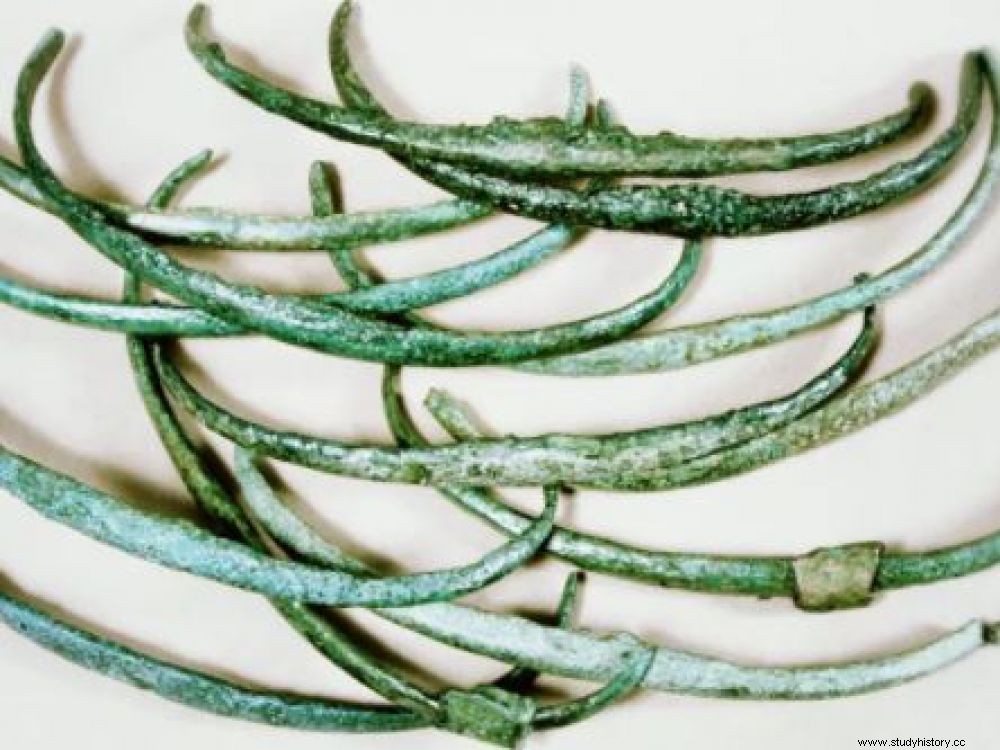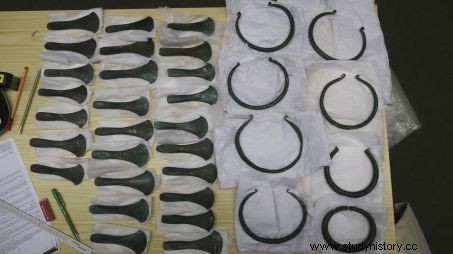Bronze objects with standardized weights could have been a form of primitive money 3,500 years ago.

These 3,500-year-old "Spangenbarren," or "curved bar ingots," may correspond to paleo-currencies in Bronze Age economies, according to a new study.
The first coins, the ones that weigh down the bottoms of our pockets, were born in the 7th century BC, somewhere in Asia Minor, near Lydia (present-day Turkey). They were then made of electrum - an alloy of gold and silver - drawn from the Pactolus river which abounded in these precious metals... It is also established that long before the use of these currencies, humans practiced barter by exchanging foodstuffs and goods. But when did they finally opt for weighed metal, i.e. a form of standardization, as an exchange system? Two archaeologists believe they have found the answer by identifying the oldest known example of commodity money in Europe from the Bronze Age, 3,500 years ago.
More than 5,000 objects were compared
In a study published January 20, 2021 in the journal Plos One the Dutch Maikel Kuijpers and Catalin N. Popa, from the European Prehistory Laboratory of the University of Leiden (Netherlands), explain that they compared 5028 objects from the Early Bronze Age (between 2150 and 1700 BC .):especially non-working axes called "socket axes" and "curved bronze bars", or Spangenbarren . All collected from 113 sites in southern Europe (Germany, Austria, Czech Republic, Slovakia, Poland), most of these objects having been intentionally buried in large numbers in pits.
 Bronze Socketed Axes and Rings, from the Carsdorf Treasure, Collection of the Naturhistorische Museum Leipzig (Germany). © MHG Kuijpers/AFP
Bronze Socketed Axes and Rings, from the Carsdorf Treasure, Collection of the Naturhistorische Museum Leipzig (Germany). © MHG Kuijpers/AFP
"The weight was crucial in determining the value of the goods"
According to the two researchers, "for 70.3% of them, their weights were so close in mass - on average about 195.5 grams - that they would have been indistinguishable if weighed at the hand" . However, no evidence of the existence of a weighing device such as scales is known for this period. "We infer that the weight was crucial in determining the value of commodities in most economic transactions" , explain the authors of the article. It is this similarity in shape and weight of objects mass-produced at the time - and therefore interchangeable - that may indicate their use as an early form of standardized currency. The authors explain that they carried out their analyzes based on the so-called Weber-Fechner law which establishes a link between mental sensation and the stimulus caused by the manipulation of objects:if these are sufficiently similar in mass, a being human weighing them by hand cannot tell the difference. They are therefore considered identical.
For Laurent Olivier, protohistorian, specialist in the anthropology of pre-Roman societies at the National Archeology Museum of Saint-Germain-en-Laye (Yvelines), "this hypothesis of paleo-money has actually been known since the beginning of the 20 e century. The originality of the study - and its novelty - comes from the sought-after contribution of cognitive sciences which establish with Weber's fractions that the real weight does not matter:only the perceived weight counts. We have to admit that we know very little about the conditions of circulation of goods in the non-monetary economies of prehistory. This study is therefore timely to revive these questions!" .
The search for the origin of monetary systems is definitely in vogue! The University of Oxford (United Kingdom) announced a few weeks ago the launch of the Change, project focused on this theme.
